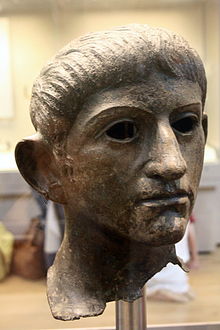Temple of Claudius, Colchester
| Temple of Claudius | |
|---|---|
 Floor plan | |
 | |
| General information | |
| Type | Roman temple |
| Architectural style | Classical |
| Location | Colchester, England |
| Address | CO1 1TJ |
| Completed | 49 AD |
| Demolished | c. 60 AD (original temple); 1070-1080 AD (second temple) |
The Temple of Claudius (Lat. Templum Claudii) or Temple of the Deified Claudius (Lat. Templum Divi Claudii) was a large octastyle temple built in Camulodunum, the modern Colchester in Essex.[1][2] The main building was constructed between 49 and 60 AD, although additions were built throughout the Roman-era.[3] Today, it forms the base of the Norman Colchester Castle.[1][4] It is one of at least eight Roman-era pagan temples in Colchester,[5] and was the largest temple of its kind in Roman Britain;[1][4] its current remains potentially represent the earliest existing Roman stonework in the country.[4]
History
After the
Construction
The podium of the temple was constructed by pouring a
The podium is rectangular, aligned north–south. The main chamber of the temple, the
Boudican revolt and aftermath

In 60/1 AD the Iceni rebelled against the Romans, joined by the Trinovantes who were native to the area around Camulodunum.[1] As the symbol of Roman rule in Britain, the colonia of Camulodunum was the first target of the rebels, with its Temple seen in British eyes as the "arx aeternae dominationis" ("stronghold of everlasting domination") according to Tacitus.[4] The town was destroyed, with survivors taking refuge in the cella of the Temple, whose large bronze doors and strong, windowless chamber provided a safe haven.[1] However, the rebels laid siege to the Temple, which was stormed after two days. Tacitus wrote:
In the attack everything was broken down and burnt. The temple where the soldiers had congregated was besieged for two days and then sacked.[4]
The decapitated bronze head of a statue was found in the River Alde in Suffolk, and has been interpreted as having been taken from the Temple of Claudius by the Iceni. It has come to be identified as a bust of the Emperor Nero, who ruled during Boudica's rebellion.[1][12] The town and temple were rebuilt in the years after the attack, with the colonia reaching a peak of population in the 2nd and 3rd centuries AD.[1][3][4] The temple was one of the main public buildings in the town, and its façade and precinct were added to and enlarged over time.[1][3]
The temple in the Late Roman town
In contrast to the scaling down of private buildings in the town during the 4th century, there was an increase in the size and grandeur of public buildings in the period 275-400 AD.
Saxon and Norman periods


Large amounts of the superstructure of the temple were standing throughout the Saxon period,[1][4] when the temple was known as King Coel's Palace.[1][5] The medieval Colchester Chronicle states that the Norman architects of Colchester Castle built the structure on the remains of this "palace" in the years 1070–1080, with archaeological evidence showing that the base of the temple was used as the foundations of the castle.[1] Evidence has been uncovered from excavations in 2014 shows that the columns of the temple precinct entrance may also have been demolished in the Norman period to allow the building of the castle's bailey.[10] The podium was rediscovered in the 17th century when the underside of the temple's base was grubbed out, creating "vaults" under the castle.[1] The underside of the castle was not identified as the podium of the temple until archaeologist Mortimer Wheeler examined it in the early 20th century and found that the Norman builders had clasped the castle's walls to the Roman concrete podium.[1] Today the 17th-century "vaults" are open to visitors, showing the underside of the temple.[4]
See also
- List of Ancient Roman temples
- Camulodunum
- Augustales
- Roman temple
- Roman architecture
- Imperial cult (ancient Rome)
- Temple of Claudius, Rome
References
- ^ ISBN 1 897719 04 3)
- ^ a b "Temple of Claudius at Camulodunon (Colchester)". retrieved 27/07/2014
- ^ a b c d e f g h Faulkner, Neil. (1994) Late Roman Colchester, In Oxford Journal of Archaeology 13(1)
- ^ ISBN 1-84119-318-6)
- ^ a b c d e f "Iron-Age and Roman Colchester | British History Online". www.british-history.ac.uk. Retrieved 27 July 2014.
- ISBN 0-9503727-4-9)
- ^ According to Tacitus the expenses for the temple's upkeep were among the cause of the Boudican Revolt: "delectique sacerdotes specie religionis omnes fortunas effundebant." i.e. "and the chosen priests wasted whole fortunes for the cult's sake." Annales 14.31
- ISBN 0-14-044489-0)
- ^ Apocolocyntosis - 8. "He wants to become a god: it's not enough that he has a temple in Britain, that the barbarians worship him and pray to him like to a god to obtain the benevolence of the idiot." - Original Latin+Greek: Deus fieri vult: parum est quod templum in Britannia habet, quod hunc barbari colunt et ut deum orant μωροῦ εὐιλὰτου τυχεῖν
- ^ a b "The Trust's investigation of Roman arcade in local press". www.thecolchesterarchaeologist.co.uk. Colchester Archaeological Trust. 25 July 2015. Retrieved 4 April 2019.
- ^ Remains of 'extraordinary' Roman arcade found in Colchester
- ^ a b "Bronze head of a Roman Emperor". British Museum.
- ISBN 1-897719-01-9)
External links
- Colchester Temples at Roman-Britain.co.uk
- The Annals of Tacitus. Book 14, Chapter 31
